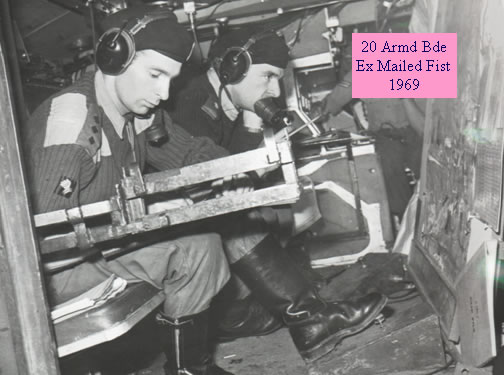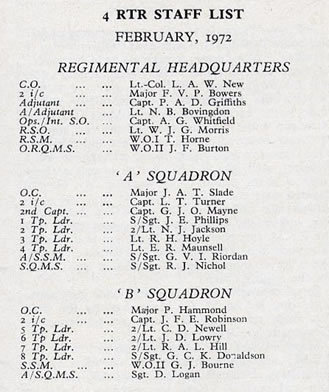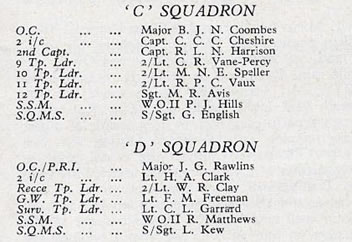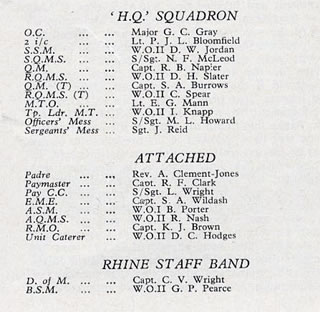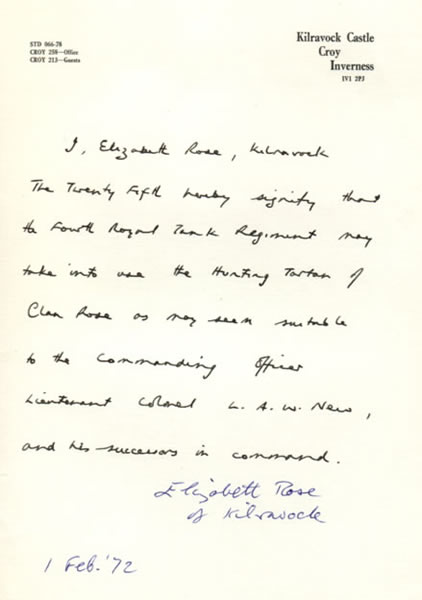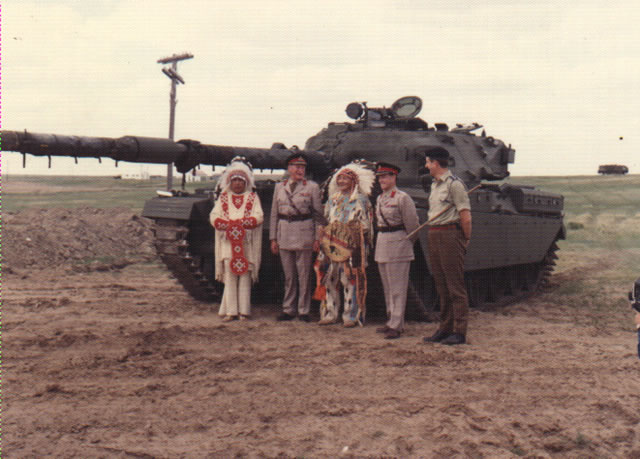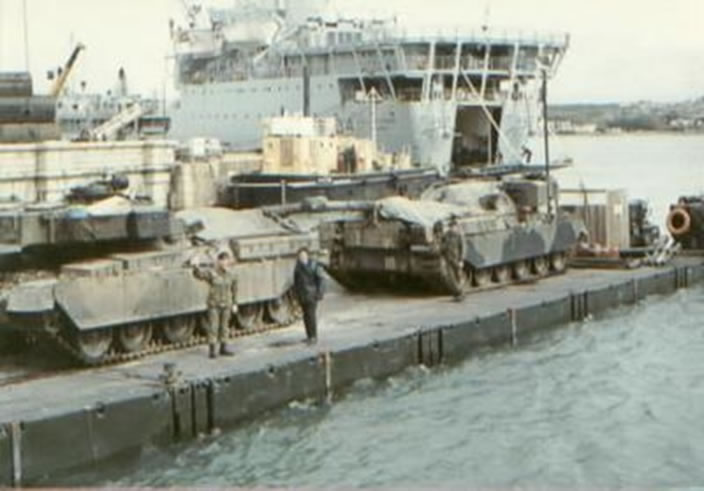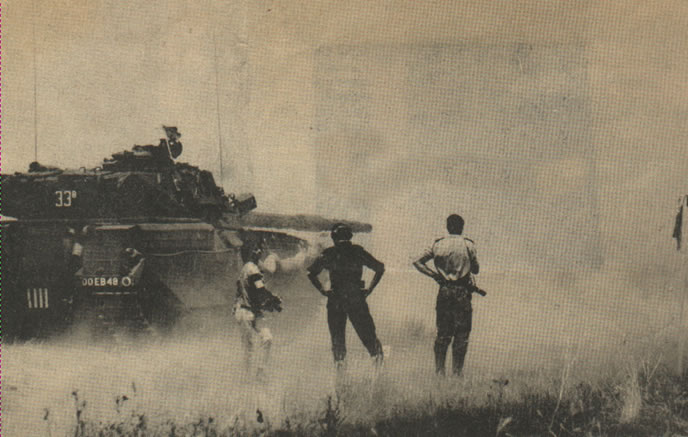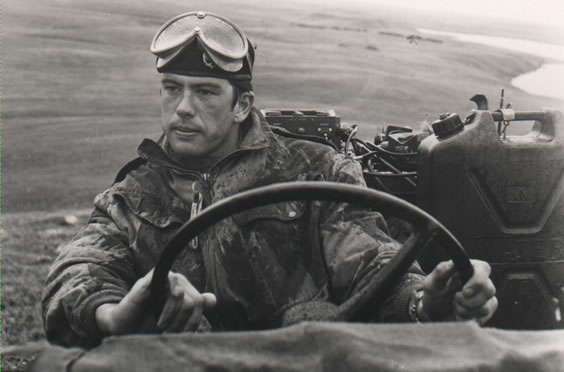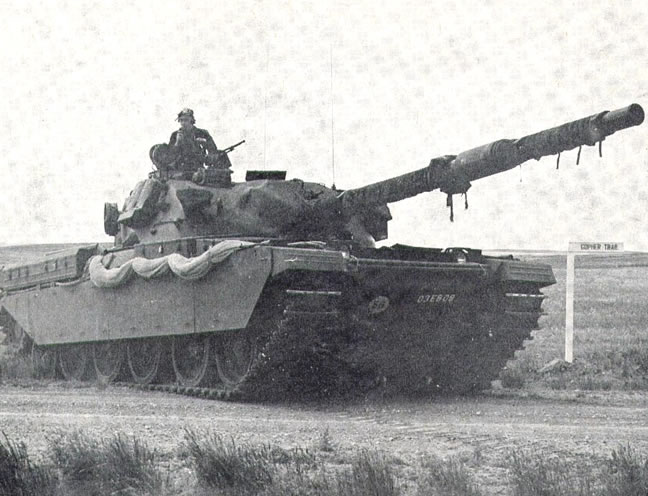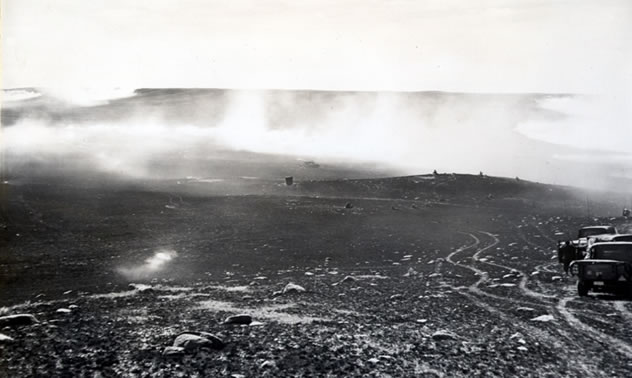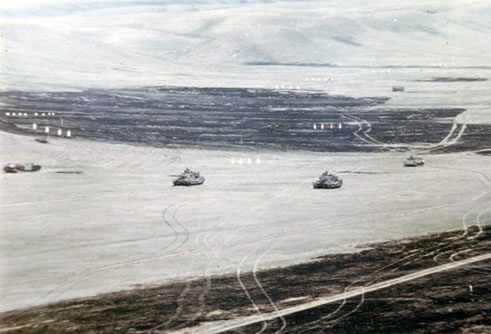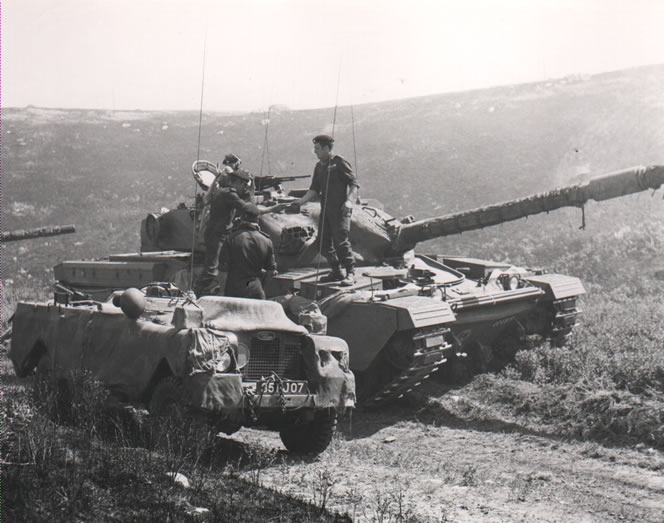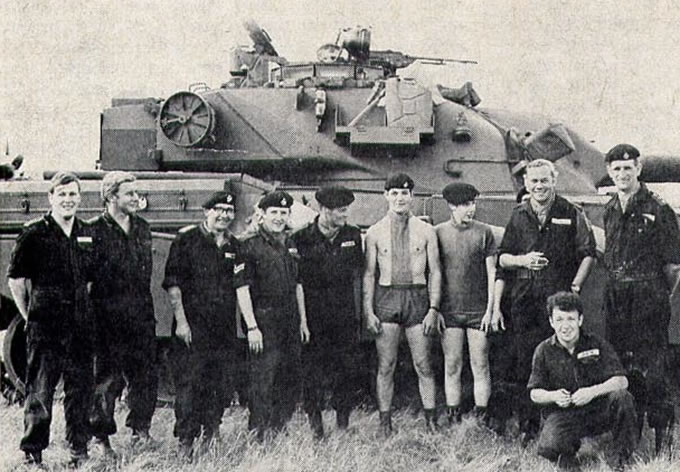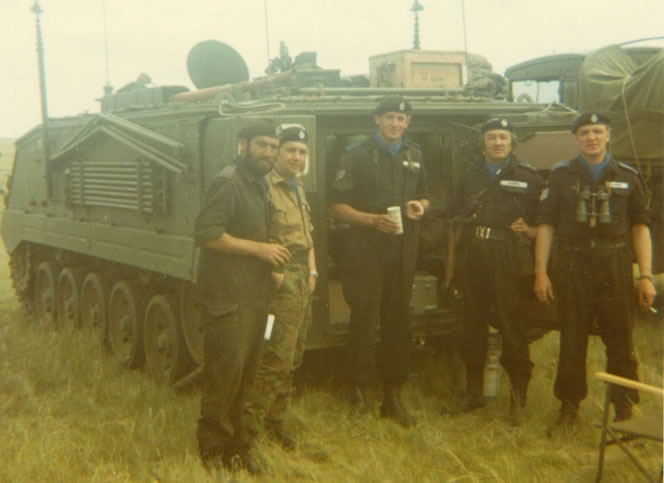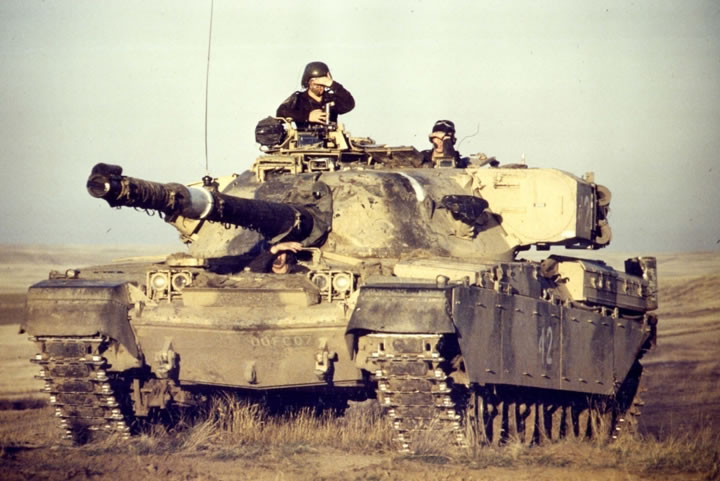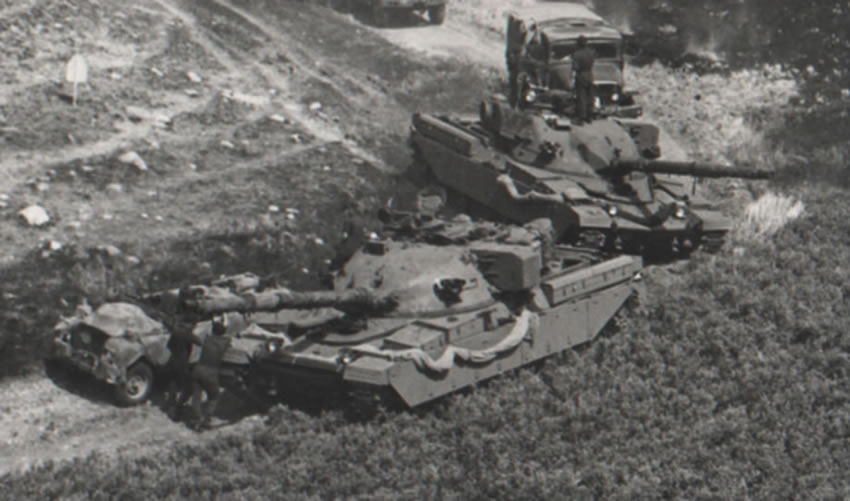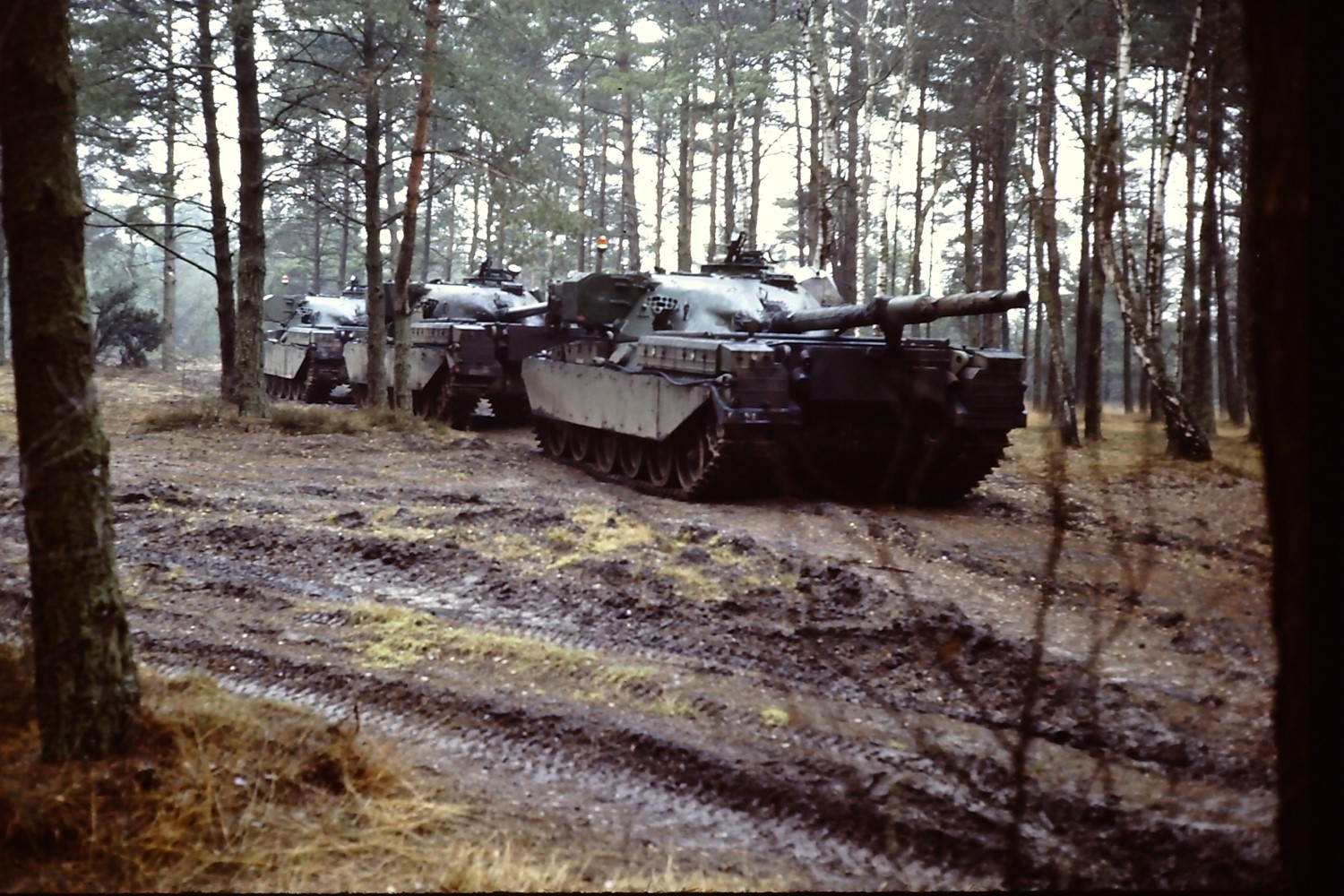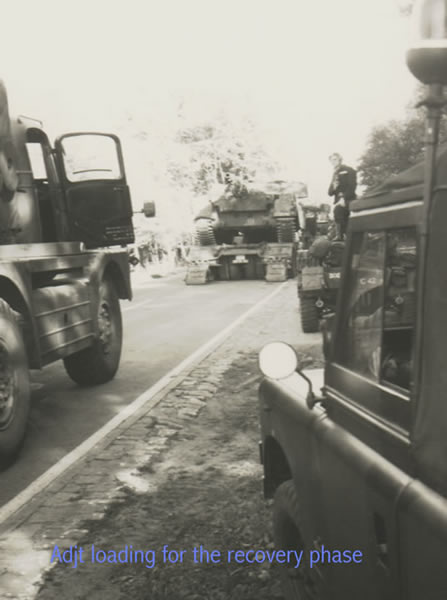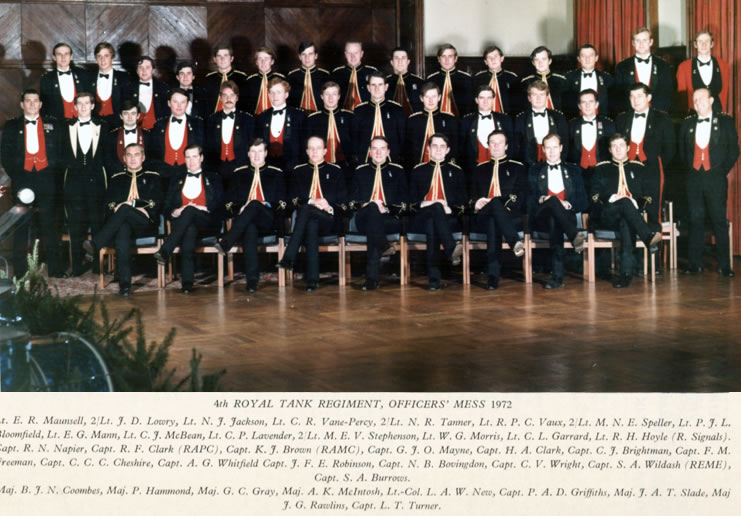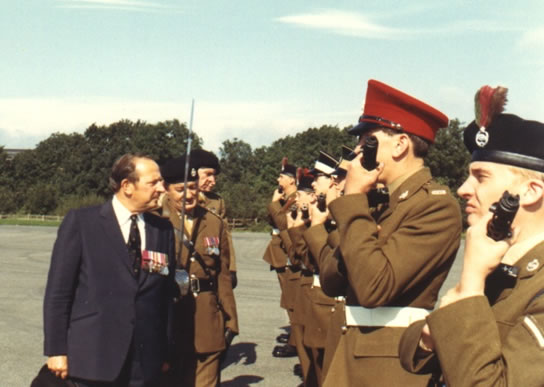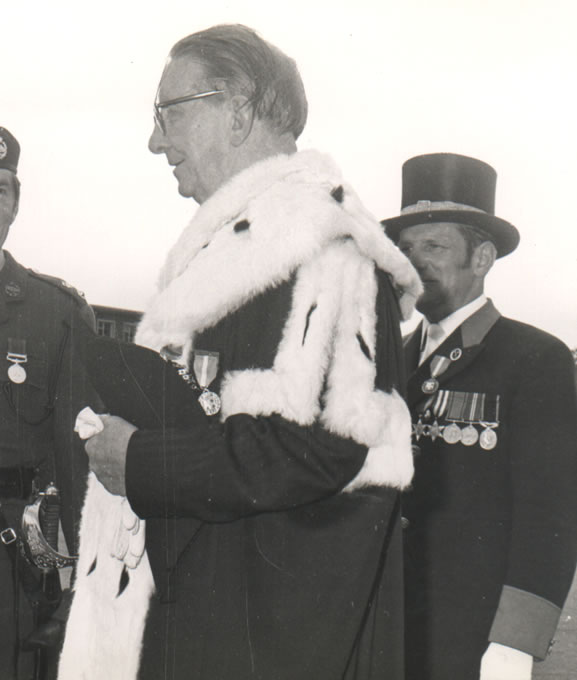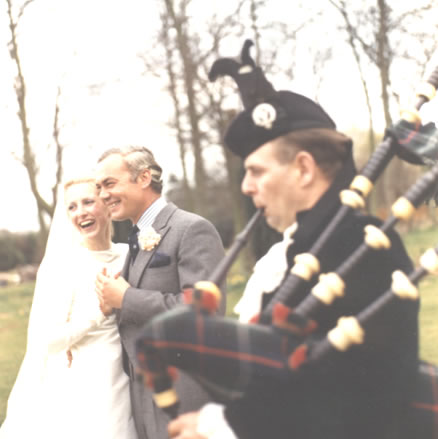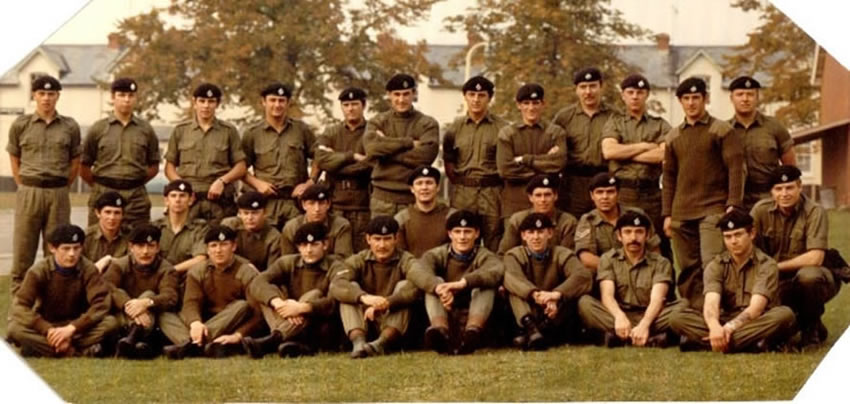1971 – 1973
Command passed to Lt Col L.A.W. New whose regimental service had been entirely in the Seventh and the Fourth, having last left the Regiment in 1967 to be Brigade Major 20th Armd Bde.
The Squadrons left Ulster with an enviable reputation, returned to Hohne in the first week of December 1971, and went on leave. In the same month RSM Eric Mann was commissioned and appointed MTO, WO1 Tom Horne replacing him as RSM.
In that same month we took an important step in reflecting the Scottish element in our past and in our present, for by now we had a high proportion of Scots at all levels. The Head of Clan Rose, a family friend of the CO, gave permission for the Fourth to take into modest use the Hunting Tartan of Clan Rose of Kilravock.
| This action was thereafter formally authorised by Lord Lyon of Scotland. | We now had the Tartan. The next more ambitious step was to create the Pipes and Drums. |
 |
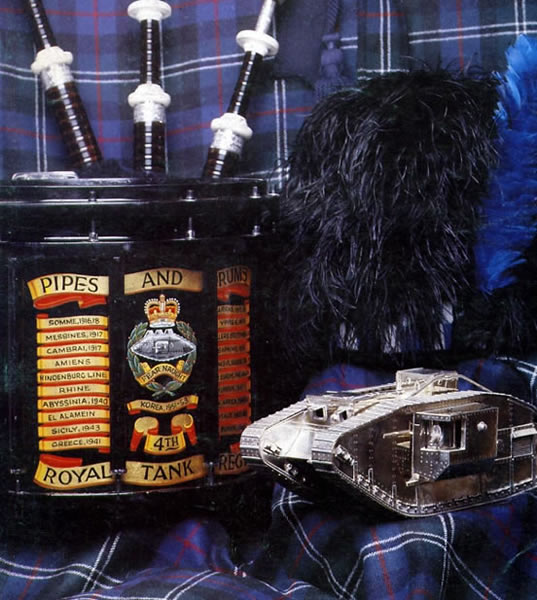 |
After post-Ireland leave the Regiment was quickly into its stride again as an armoured regiment and was kept at short notice to deploy. The Regiment was fully manned. A boost to operational readiness came with the news that in May/June the 4 RTR Battle Group would be the first to train on the extensive Suffield Training Area at Medicine Hat in Canada. AFV’s were being pre-positioned. “A” Company The Green Howards, 55 (The Residency) Battery, 49 Regt RA, plus two tps 32 Armd Engr Regt and supporting elements would make up the Battle Group.
The principal event before Suffield was range firing which we were to carry out at NBC Red. Protective clothing and respirators were worn in all firing and while bombing-up and in hides. It hadn’t been attempted before other than in trials units. It seemed a logical challenge and we all learned a great deal. Night firing was especially difficult, where respirator eyepieces made it that much more difficult for those with glasses to see through gun-sights. These difficulties reduced our gradings but we achieved our objective, and raised some important questions about related equipment.
Fitness for Role (FFR) Inspection, troop and squadron training and tactical preparation also had to be squeezed into an already full programme.
While we were making final preparations at Hohne Camp Crowfoot was being readied and handed over to our Advance Party.
From R to L Captain C. C. Cheshire, Colonel T A Gibson (Comdt Suffield), Chief Crowfoot, QMG and A N Other Chief.
The Main Party flew the 4,500 miles to Calgary on 12 June 1972. Camp Crowfoot was only just ready, some of the cement still being wet and the all-important wash-down facilities yet to be constructed.
The elements of the BG spent the first two days in sub-unit training. For the tank crews this involved controlled shoots using APDS III (newly issued very high velocity service ammunition) which we had never fired in BAOR. The Canadian press interest was high.
We were also allowed to do some recce of the area. Here (the late) Lt Andrew Hill tries not to be too impressed by the size and scope of the terrain.
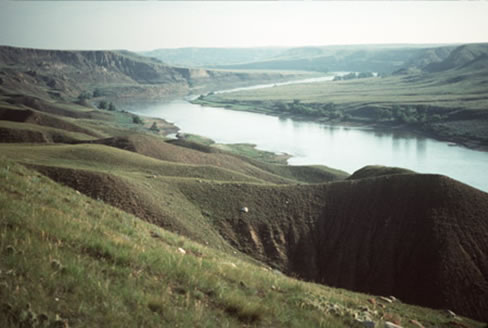 |
 |
The Training Area was some 750 sq miles and there was ample room for live fire and manoeuvre. There were many hard targets including pristine Centurion hulls.
It was almost time to leave the comfort of Camp Crowfoot and move out to the unknown hazards of the prairie. Cpls James Thompson and Euan Monroe, Tprs Kenneth Scott, Alexander McBride and Sandy Hamilton getting into the mind-set.
After a close bridge garrison and reserve demolition night exercise involving live firing by all elements of the BG we were ready for the 48 hr “Battle-Run Blenheim”. Our tracers set fire to the extensive scrub which had never previously been burned except by lightning strike. It certainly added to the realism; there was smoke everywhere.
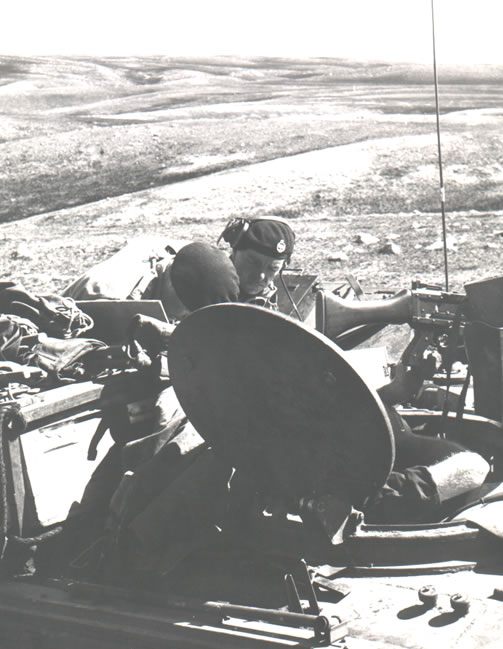 |
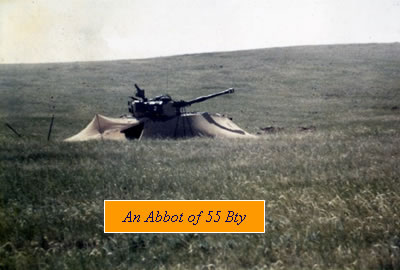 |
The CO and the Bty Comd, Major Bryan Webber, agree the fire plan for the final phase of Battle Run Blenheim.
Exercise ends. We had learned a great deal and looked forward to the mid-Suffield long weekend in the Rockies.
The Rockies were spectacular and the people of Banff made us very welcome. British soldiers were a novelty and we made the most of it.
| Lt Andrew Hill and troop merging with the scenario | Capts Whitfield and Bloomfield and friends on horseback. | |
 |
 |
 |
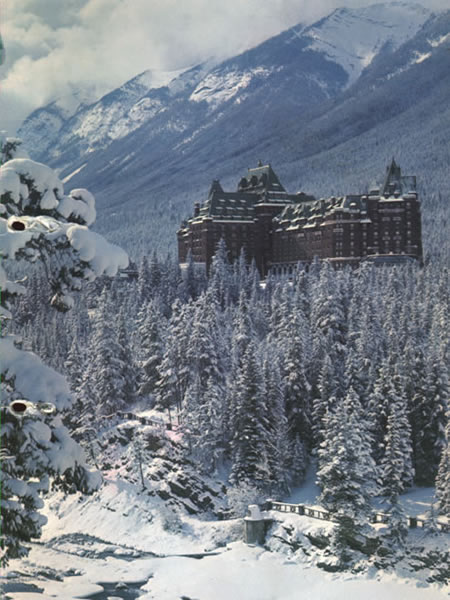 |
 |
Being the first Battle Group to train in Canada we were indulged at Suffield and at Banff. After an exuberant Battle Group dinner party at the Banff Springs Hotel the younger officers abseiled down from the seventh floor without recrimination.
But it was time to get back to Suffield.
RHQ Tac team ready for the off.
L to R bearded Tpr Barnett, Cpl Ponting, Sgt Waddell (COs tank operator/loader)
Lt Garfield Morris (RSO) and Sgt Hardy
…except for the few tanks with Decca navigators; but they couldn’t fire main armament when the navigators were running!
A 1 Echelon comes forward to replenish. Note the success in preventing the fire spreading across the track.
The final night of Ramillies included a spectacular night firing by all elements of the BG against an array of tactically deployed hard targets.
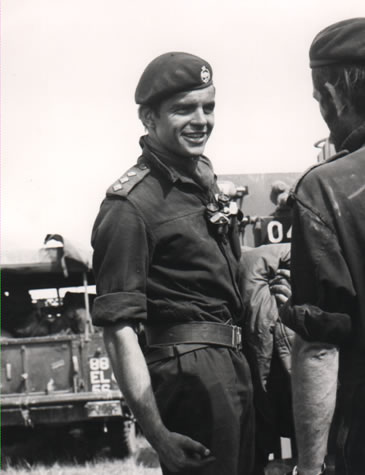 |
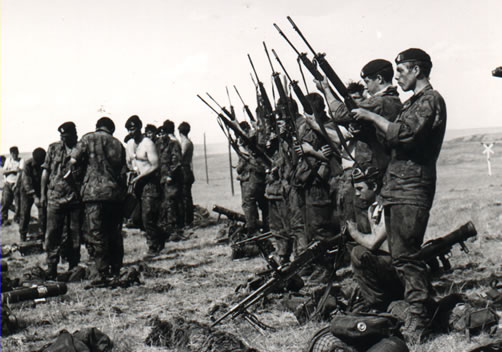 |
Battle-run Ramillies had been tiring but professionally very satisfying, and the best training most of us had ever experienced.
Suffield was voted excellent value and we were quite reluctant to leave the prairie. Captain Andrew Whitfield (Ops Offr) and Peter Griffiths (Adjt) with the CO.
The CO remarked “Suffield was a first for everyone including the host safety team who exercised ultimate control. I know we could have done better. There was at that time no Battle Group and Combat Team Trainer at Sennelager, and we had no opportunity for pre-BATUS training as a Battle Group. We learned a great deal at Suffield – quickly, and we came home without loss.”
Our last five weeks in Germany were hectic, with the farewell service of dedication on Cambrai Day; giving a major live- fire Battle Group demonstration to RCDS; farewell balls in the Officers and Sergeants messes; moving “A” Squadron to Berlin; handing over to the QDG and preparing to take on the training role in UK seamlessly.
As part of the Farewell Service in Bergen the Commanding Officer laid a wreath at the German War Memorial.
S/Sgt English, RSM Horne, RQMS Slater (and part of S/Sgt Nichol) in the Standard Party.
Pipe Sergeant Elder made his first public appearance, albeit dressed as a piper of Clan Rose, playing after the service during the wreath laying. His recruitment is described in Annex B.
GOC 1 Armd Div, General (later Field Marshal) The Lord Bramall who became CGS and finally CDS, sent an encouraging farewell message.
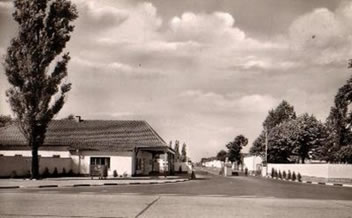 |
 |
The Regiment said Farewell to BAOR in December 1972, resolved to make a success of Berlin and Catterick.
The Regiment settled into Catterick and Berlin determined to be positive. There were many bonuses.
- Generally good accommodation and quarters.
- The opportunity to rotate young leaders through the Berlin Squadron.
- The pleasures of being nearer to parents, families and friends.
- A worthwhile and challenging job, changing boys into men.
- The opportunity to upgrade all 4 RTR ranks in crewman and other trades.
- Good opportunities to recruit from Scotland.
- Closer association with our old comrades in Northern England and Scotland.
- The opportunity to invite distinguished friends and previous Regimental heroes eg. Pip Gardner to take Passing out Parades.
- Having the Rhine Staff Band living with us.
- Having some excellent officers and NCOs attached from affiliated regiments.
- The opportunity to enjoy silver, paintings etc loaned (and later gifted) to the Regiment by the Lowland Yeomanry, a veritable treasure trove.
- The warm welcome from local civilians.
A Squadron were soon settled in Berlin. They were at a high state of readiness, fully bombed-up and ready to deploy at all times.
At Catterick the Regiment was committed to fortnightly basic training Passing-out Parades. After six weeks of training even their mothers didn’t recognise them ! It was an opportunity to invite a variety of Inspecting Officers. Here Captain Pip Gardner VC, MC, inspects Lieutenant Garfield Morris’s Intake Troop.
In addition to basic training the Regiment was responsible for first stage tank and armoured car crew training.
The Provost of Hawick was another Inspecting Officer. Such occasions generated goodwill in the Fourth’s main recruiting areas.
Having the Rhine Staff Band co-located greatly facilitated the regular Parades. Here BSM Pierce and the Fanfare Trumpeters.
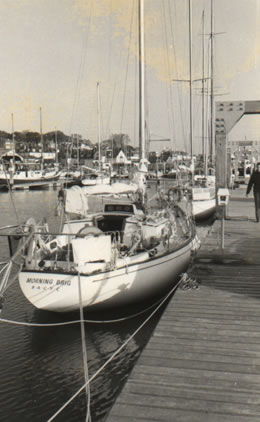 |
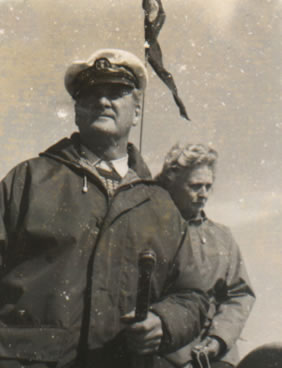 |
Having an entirely predictable life it was easier to send officers and men on detachment to Northern Ireland and Malaysia, on many courses and very varied adventure training. Brigadier Sir Freddie Coates (a distinguished former member of the Regiment) kindly trained many to be RYA skippers. He was invariably supported by Lady Coates, seen here.
The Fourth were looking for more ways to recognise their Scottish identity and incidentally help recruiting in the fiercely competitive Scottish environment. As explained in Annex B Pipe Sergeant Elder had been “poached” in 1972 from the RSDG in order to train and form a Pipes and Drums. The Regiment was very enthusiastic and in 1973 he began to play an increasing part in the Fourth’s public and private lives.
When the Pipes and Drums initiative came to the ears of GOC Scotland he was entirely opposed. The RTR Colonels Commandant to whom GOC Scotland appealed, ordered an immediate stop, saying that it would be as offensive to Royal Tank Regiment tradition as it was to the Scottish regiments. How that somewhat hesitant start led to the Pipes and Drums as they are shown below on their 21st Anniversary, recognised by the Army Board and applauded by our Colonel-in-Chief, is told at Annex B.
A further initiative that we launched in 1973 was to rename HQ Sqn as G Sqn as an evident reminder of our heritage from the Seventh Royal Tank Regiment.
The steady rhythm of the Regiment continued throughout 1973. Major Neil Winship succeeded Major John Slade as OC A Sqn in Berlin in February. The RTR Reunion weekend was staged at Catterick 23-24 June 1973. Three hundred and eighty former members and old comrades attended.
 |
 |
Seconds-in-Command tend to have a low profile. The Fourth was very fortunate at this time in having Major Keith McIntosh quietly pulling all the strings. All his regimental service had been in the Fourth. He later commanded the HQ I (Br) Corps Regiment.
 |
 |
On 1 July 1973 we took Pipe Major Elder to Kilravock Castle to meet with and to play for the Head of Clan Rose. She was delighted.
In September the inaugural Fourth and Seventh Reunion was held at Catterick. Some two hundred old comrades from the two regiments attended including some very distinguished Old Boys, as indicated on this programme.
From L to R Major General H R B Foote VC, DSO, MC; General Sir Alan Jolly GCB, CBE, DSO; Captain Pip Gardner VC, MC; Robert New and Major General A R Leakey CB, DSO, MC.
The weekend was a memorable mixture of reminiscence, sporting challenge, ceremony and corporate worship. Pipe Sgt Elder played at the Sunset ceremony.
 |
 |
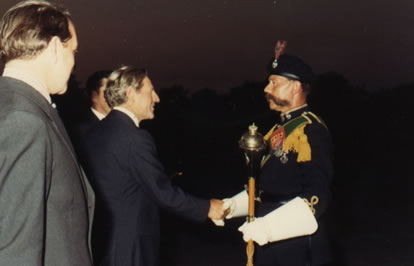 |
After the formal dinner our Two VCs chat with In-Pensioner Candy and Mrs Anna New, the Commanding Officer’s wife.
 |
 |
Left, General Sir Alan Jolly reminisces with In-Pensioner Walker after the Church Parade. Were they perhaps recalling Colonel Jolly’s briefing of the Fourth before the Rhine Crossing in March 1945?
Our two VCs pose by “Dulwich”, named after the Public School at which Pip Gardner was educated.
It had been a memorable weekend.
In November 1973 members of the Regiment took part in “Exercise Invariant”, jungle warfare training in Malaya – shades of 1966.

